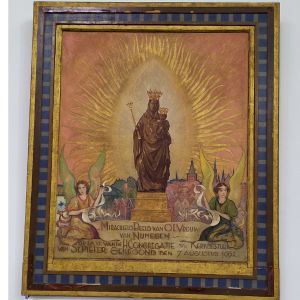Fr. Wolff had a special love and devotion to Mary, our Blessed Mother. He venerated her as the Mother of God and the Mother of the Church.
09 Aug 2025 - 31 Aug 2025
Fr. Wolff had a special love and devotion to Mary, our Blessed Mother. He venerated her as
the Mother of God and the Mother of the Church. He followed her example and sought her
guidance at every moment of his life. One expression of his love and devotion to Mary
remains visible to this day in the Church of St. Peter Canisius in Nijmegen, NL. The small
wooden statue of Our Lady of Nijmegen, located in the side chapel of the church, dates back
to the 16th century. This was presented to Fr. Wolff by Mr. Anton Van Veersen in 1836, and
Fr. Wolff placed it in the church, helping people develop devotion to Our Lady of Nijmegen.
The statue miraculously survived the bombings of 1944 and is preserved to this day. As a
sign of his great devotion to the intercession and inspiration of Mary, Fr. Wolff also
instructed the Sisters of JMJ about the virtuous life of Mary and urged them to follow her
example in their daily lives. One of those instructions, written in the form of a meditation on
the ‘humility of the Virgin Mary’, is partially presented below. 1 Fr. Wolff writes,
1) Great was Mary’s humility when the Angel came to her with a message from God. When
the messenger of God exalted Mary above all women and called her full of grace, and greeted
her as the mother of the Saviour of the world, she humbled herself as deeply as possible,
saying: Behold the handmaid of the Lord! Later, she said again: The Lord has looked upon
the lowliness of his handmaid. Thus, the holy rule teaches us to humble ourselves in
everything and to seek constant self-denial in all things. This is also strongly recommended
by St. Ignatius of Loyola when he says that one must walk the path of humility if one wants
to do something great for God.
2) Mary’s humility was great in the house of her cousin Elizabeth. As soon as Mary was
greeted by the angel as full of grace, as the beloved daughter of God the Father, the dear
mother of God the Son, and the chosen bride of God the Holy Spirit, she left her home and,
driven by the spirit of humility, set out across the mountains (to her cousin Elizabeth). She,
who had confessed with her mouth that she was only a servant of the Lord, also wants to
show (in action) that she gladly serves God; for when she came to her cousin, she stayed with
her for a while, not to be served, but to serve. She is already practising what her Son tells us
all: learn from me, for I am gentle and humble in heart. We see that the greater Mary is
before God, the more humble she is before herself; we should therefore humble ourselves
according to this example, in proportion to our merits.
3) Mary’s humility was great when she placed herself among the other women in the temple
according to the law of purification, and when she dedicated her child to God and redeemed
him with a pair of turtledoves or a pair of young pigeons. She was not obliged to do this; after
all, her Son was the lawgiver Himself, and yet out of humility, she did everything strictly
according to the law; and to humble herself even more, she did not give the offering of the
rich (sheep/goat), but that of the poor (doves/pigeons). Throughout her life, we observe that
she was consistently motivated by the same spirit of humility. It is also our duty, according to
our promises (vows) and good intentions, to humble ourselves and die to ourselves in all
things and at all times, to follow the example of Jesus Christ himself and of his Holy Mother.
Image 1 – The painting depicts the miraculous statue of Our Lady of Nijmegen

Image 2 - The recent visit of the JMJ sisters to the same statue at Nijmegen (May 2025)


